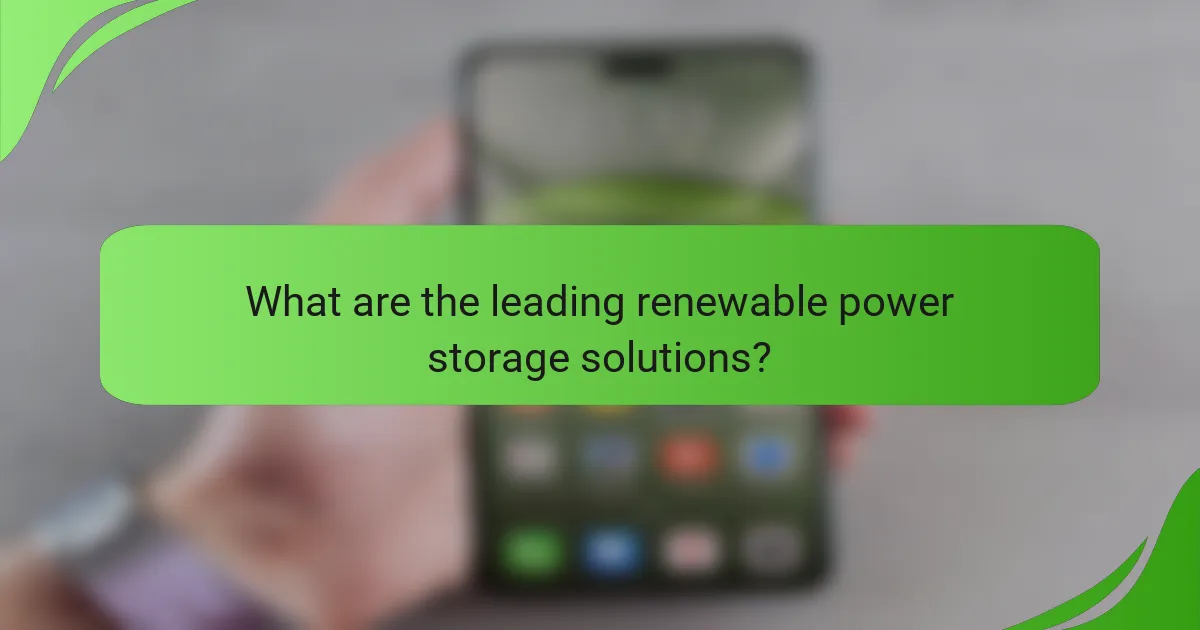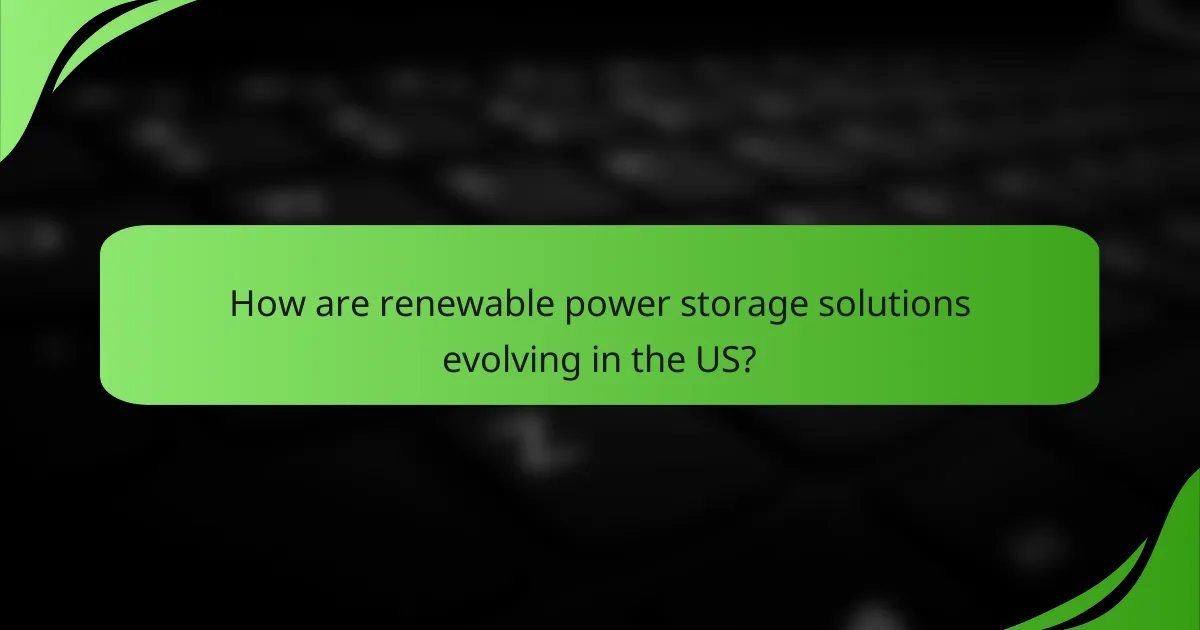As the demand for sustainable energy grows, renewable power storage solutions are becoming increasingly vital in the energy landscape. Technologies such as lithium-ion batteries, pumped hydro storage, and flow batteries are at the forefront, each presenting unique benefits and challenges. Innovations in this sector are enhancing efficiency and reducing costs, paving the way for a more reliable and environmentally friendly energy future.

What are the leading renewable power storage solutions?
The leading renewable power storage solutions include lithium-ion batteries, pumped hydro storage, flow batteries, compressed air energy storage, and solid-state batteries. Each solution offers unique advantages and challenges, making them suitable for different applications in energy storage and management.
Lithium-ion batteries
Lithium-ion batteries are widely used for energy storage due to their high energy density and efficiency. They work by moving lithium ions between the anode and cathode during charging and discharging, allowing for quick energy release and recharge cycles.
These batteries are ideal for applications ranging from electric vehicles to grid storage, but they can be expensive and have a limited lifespan. It’s essential to consider factors like temperature sensitivity and recycling options when choosing lithium-ion technology.
Pumped hydro storage
Pumped hydro storage is a mature and large-scale solution that utilizes gravity to store energy. It involves pumping water to a higher elevation during low-demand periods and releasing it to generate electricity during peak demand.
This method is highly efficient, often exceeding 70% efficiency, and can provide substantial energy storage. However, it requires significant geographical features and infrastructure, making it less feasible in flat regions or urban areas.
Flow batteries
Flow batteries store energy in liquid electrolytes contained in external tanks, allowing for scalable energy storage. They operate by circulating the electrolytes through a cell stack, where chemical reactions produce electricity.
These batteries can be charged and discharged simultaneously, making them suitable for renewable energy integration. While they have lower energy density compared to lithium-ion batteries, their long cycle life and ability to scale make them a compelling option for large installations.
Compressed air energy storage
Compressed air energy storage (CAES) involves storing energy by compressing air in underground caverns or tanks. When energy is needed, the compressed air is heated and expanded to drive turbines and generate electricity.
This method can provide large-scale energy storage and is particularly useful for balancing intermittent renewable sources. However, it requires specific geological formations and can have lower efficiency compared to other storage technologies.
Solid-state batteries
Solid-state batteries are an emerging technology that replaces the liquid electrolyte in traditional batteries with a solid electrolyte. This design enhances safety and energy density while potentially reducing costs over time.
While still in development, solid-state batteries promise longer lifespans and faster charging times. As research progresses, they may become a game-changer for electric vehicles and stationary energy storage applications, but widespread adoption is still a few years away.

How are renewable power storage solutions evolving in the US?
Renewable power storage solutions in the US are rapidly advancing, driven by technological innovations and increasing demand for sustainable energy. These developments focus on enhancing efficiency, reducing costs, and integrating with smart grid systems to optimize energy use.
Increased efficiency
Efficiency in renewable power storage is improving through advancements in battery technology, such as lithium-ion and solid-state batteries. These innovations allow for faster charging times and longer lifespans, which are crucial for maximizing energy retention and usage.
For instance, modern batteries can achieve energy efficiencies exceeding 90%, meaning that a significant portion of stored energy can be utilized effectively. This is essential for balancing supply and demand, especially during peak usage times.
Cost reductions
The costs associated with renewable power storage have decreased significantly over the past decade, primarily due to advancements in manufacturing processes and economies of scale. Prices for lithium-ion batteries have dropped by over 80%, making them more accessible for both residential and commercial applications.
As the market continues to grow, further reductions are expected, potentially bringing costs down to the low hundreds of USD per kilowatt-hour. This trend encourages more widespread adoption of renewable energy solutions across the US.
Integration with smart grids
Integrating renewable power storage with smart grids enhances the overall efficiency of energy distribution. Smart grids utilize advanced communication technologies to manage electricity flow, allowing for real-time adjustments based on demand and supply fluctuations.
For example, energy storage systems can store excess energy generated during low-demand periods and release it during peak times, reducing strain on the grid. This synergy not only improves reliability but also supports the transition to a more sustainable energy landscape in the US.

What are the benefits of renewable power storage?
Renewable power storage offers significant advantages, including enhanced grid stability, energy independence, and reduced environmental impact. These benefits make renewable energy sources more reliable and efficient, ultimately supporting a transition to a sustainable energy future.
Grid stability
Renewable power storage systems, such as batteries and pumped hydro storage, help maintain grid stability by balancing supply and demand. They store excess energy generated during peak production times and release it when demand is high, preventing blackouts and ensuring a steady energy supply.
For example, during sunny or windy days, solar panels or wind turbines may produce more energy than needed. Storage solutions can capture this surplus, allowing utilities to manage energy flow effectively and maintain grid reliability.
Energy independence
By investing in renewable power storage, countries can reduce their dependence on imported fossil fuels. This shift enhances energy security and stabilizes local economies, as energy resources become more localized and less susceptible to global market fluctuations.
For instance, regions with abundant solar or wind resources can harness these energies and store them for later use, decreasing reliance on external energy sources and fostering self-sufficiency.
Environmental impact reduction
Renewable power storage significantly lowers greenhouse gas emissions by enabling a higher share of clean energy in the grid. By storing energy from renewable sources, it reduces the need for fossil fuel-based power generation during peak demand periods.
Moreover, as storage technologies improve and become more widely adopted, the overall carbon footprint of energy systems diminishes. This transition not only benefits the environment but also aligns with global climate goals, promoting a cleaner, more sustainable future.

What are the challenges facing renewable power storage?
Renewable power storage faces several significant challenges that can hinder its widespread adoption. Key issues include high initial costs, limited lifespan of technologies, and regulatory hurdles that can complicate implementation.
High initial costs
The high initial costs of renewable power storage systems can be a major barrier for both consumers and businesses. Technologies such as lithium-ion batteries and pumped hydro storage require substantial upfront investments, often ranging from thousands to millions of dollars depending on the scale. This financial hurdle can deter potential adopters, especially in regions with limited funding options.
To mitigate these costs, stakeholders can explore government incentives, grants, or financing options that may be available. Additionally, investing in research and development can lead to cost reductions over time, making these technologies more accessible.
Limited lifespan of technologies
Many renewable power storage technologies have a limited lifespan, which can impact their overall efficiency and return on investment. For example, lithium-ion batteries typically last between 5 to 15 years, depending on usage and maintenance. This limited durability necessitates planning for replacement and can lead to increased long-term costs.
To address this issue, users should consider the total cost of ownership, including maintenance and replacement cycles, when evaluating storage options. Exploring newer technologies with longer lifespans or better recycling capabilities can also be beneficial.
Regulatory hurdles
Regulatory hurdles can significantly complicate the deployment of renewable power storage solutions. Different regions may have varying regulations regarding energy storage systems, grid integration, and safety standards. Navigating these regulations can be time-consuming and may require legal expertise.
To overcome these challenges, stakeholders should stay informed about local regulations and engage with policymakers to advocate for supportive frameworks. Building partnerships with local utilities can also facilitate smoother integration of storage solutions into existing energy systems.

How to choose the right renewable power storage solution?
Choosing the right renewable power storage solution involves assessing your energy needs, evaluating available space, and considering budget constraints. Each factor plays a crucial role in determining the most effective and efficient system for your specific situation.
Assess energy needs
Start by calculating your average energy consumption to understand how much storage capacity you require. Consider peak usage times and whether you need storage for daily use or longer-term backup. For residential applications, this might range from a few kilowatt-hours (kWh) to several tens of kWh, depending on household size and energy habits.
Additionally, evaluate the types of renewable energy sources you plan to use, such as solar or wind, as this will influence the storage solution. For instance, solar energy systems often require batteries that can store energy generated during sunny days for use at night.
Evaluate space and location
Space availability is critical when selecting a renewable power storage solution. Assess the physical space in your home or facility to determine where storage units can be installed. For instance, battery systems may require dedicated areas in garages or basements, while larger installations might need outdoor space.
Location also affects the choice of technology. In urban areas, compact solutions like lithium-ion batteries may be preferable, while rural settings might accommodate larger systems like pumped hydro storage. Ensure that the chosen solution complies with local regulations regarding installation and safety.
Consider budget constraints
Your budget will significantly influence the type of renewable power storage solution you can implement. Prices for storage systems can vary widely, from a few thousand USD for smaller residential batteries to tens of thousands for larger commercial setups. It’s essential to factor in not just the initial purchase price but also installation costs and potential maintenance expenses.
Look for incentives or rebates offered by local governments or utility companies that can help offset costs. Additionally, consider the long-term savings on energy bills, as effective storage solutions can reduce reliance on grid power during peak pricing times.
